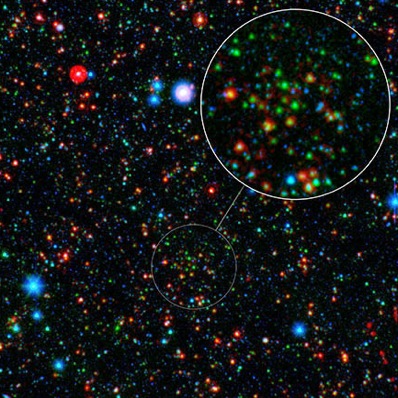
Galaxies' glory days revealed
DR EMILY BALDWIN
ASTRONOMY NOW
Posted: 19 August 2010


Observations of one of the Universe's most distant galaxy clusters reveal that a signification population of its galactic inhabitants are still churning out stars.
Using data from NASA's Spitzer Space Telescope Multiband Imaging Photometer for Spitzer (MIPS), a team of astronomers have probed a 10 billion year old cluster known as CLG J02182-05102, which hosts around 60 galaxies. Despite being formed just four billion years after the big bang, it is still producing hundreds to thousands of new stars each year – a much higher rate than even some younger galaxies.

Astronomers have found that stars are forming more rapidly in the centre of distant galaxy cluster CLG J02182-05102 than at its edges, the exact opposite to galaxy clusters seen in the local Universe. Image: NASA/JPL-Caltech/K. Tran (Texas A&M University).
The team, lead by Dr Kim-Vy Tran at Texas A&M University, also made the surprising discovery that the stellar birthrate is higher in the cluster's centre than at the edges, the exact opposition of conditions in our local Universe.
“A well-established hallmark of galaxy evolution in action is how the fraction of star-forming galaxies decreases with increasing galaxy density,” explains Tran. “In other words, there are more star-forming galaxies in the field than in the crowded cores of galaxy clusters. However, in our cluster, we find many galaxies with star-formation rates comparable to their cousins in the lower-density field environment.”
The reason behind this increased star power in densely packed regions remains a mystery – perhaps activity is triggered between nearby galaxies, or maybe all galaxies were extremely active when the Universe was young. In any case, nearby clusters host stars that are at least 8-10 billion years old, suggesting that CLG J02182-05102 is nearing the end of its hyperactive star-building period.
The observations will help shed light on when and why massive clusters turn off their star formation factories. “Our study shows that by looking farther into the distant Universe, we have revealed the missing link between the active galaxies and the quiescent behemoths that live in the local Universe,” says Tran. “Our discovery indicates that future studies of galaxy clusters in this red-shift range should be particularly fruitful for understanding how these massive galaxies form as a function of their environment.”
The hunt is now on to find similar behaviour in other galaxies. “We will analyse new observations scheduled to be taken with the Hubble Space Telescope and Herschel Space Telescope to study these galaxies more carefully to understand why they are so active,” adds Tran.
|



